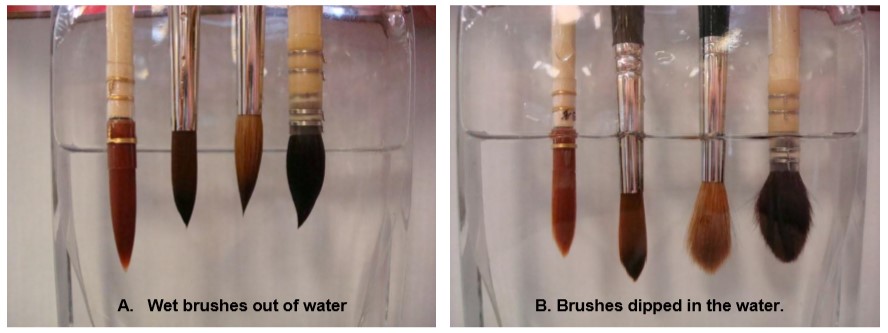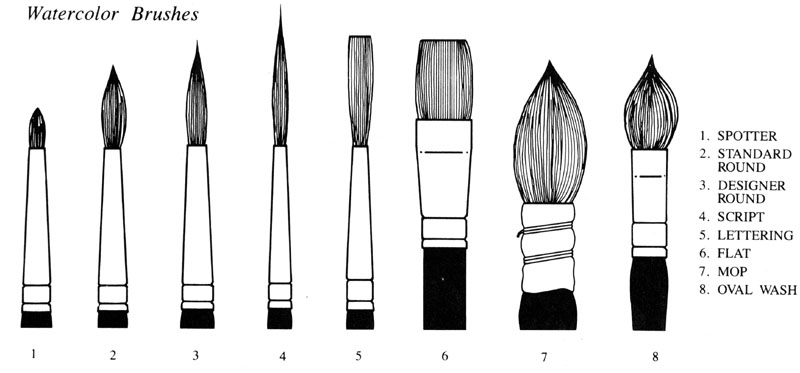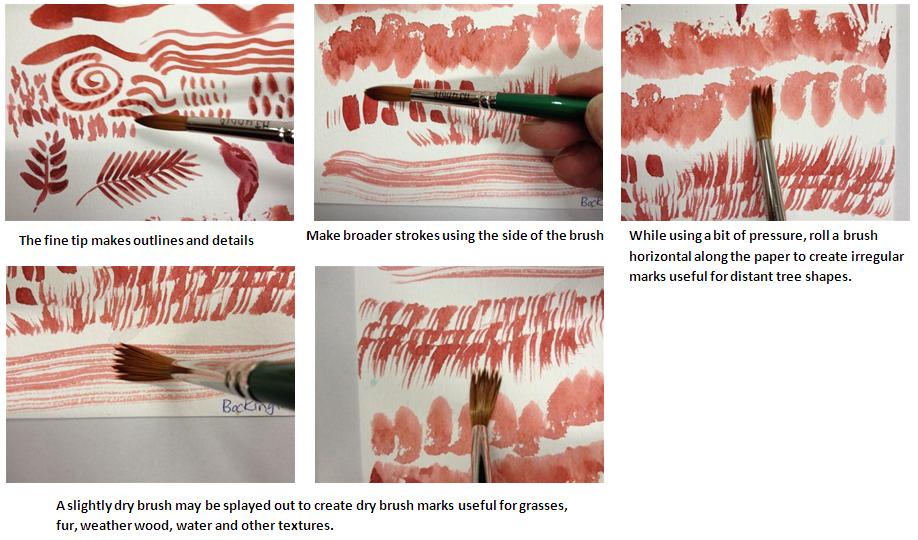Most brushes comprise of a handle, usually wooden; a ferrule, usually metal; and hair: natural animal hair, synthetic ‘hair’, or a blend of the two. Watercolour brushes are designed to suit watercolour, not oil or acrylic paint. Brushes vary hugely in price, size, shape, and material. Brush quality varies, too, so it is wise to learn about brushes and consider what you need before buying.
Tips for choosing watercolour brushes
With better materials – including brushes – it is easier to make better artwork, so consider value not just price point when selecting your brushes. In making brush choices, you may wish to question the sources of animal hair for ecological reasons: are the animals wild, farmed, endangered, or harvestable? Remember, synthetic brushes are derived from the plastics industry while natural hairs, under careful management, are renewable.
Watercolour brushes are instantly recognizable by their handles, which are generally shorter than those of acrylic and oil brushes. Watercolourists often work on a surface close to themselves, with the brush angled downwards, encouraging the paint’s flow. Most watercolour brushes use natural hair, sometimes mixed with synthetic hair. Some all-synthetic brushes are also available. Judge a Watercolour brush by its capacity to hold water and release it steadily as you move the brush. The best watercolour brushes will maintain their shape (e.g., a fine tip) while you work.

A. Wet brushes out of water and B. Brushes dipped in the water.
Natural hair is superior to synthetic. The above sample illustrates brushes made from different hairs, Wet (A) and submerged in water (B). Left to right, the brushes are da Vinci’s CosmoTop natural hair brush; a basic synthetic brush; da Vinci’s Pure Kolinsky Sable; and finally, a Raphael Natural Squirrel hair. In Photo A, we see the difference between wet brushes. Notice, natural hair brushes come to finer longer points and possess fatter bellies to hold water. Photo B shows the same brushes submerged in water. See how the natural brushes fan out to grab more water than their synthetic counterparts, which hardly appear different in or out of water. Another point to consider is that synthetics are smooth while natural hairs have follicles that also help hold more water and provide more control.
A. Watercolour brush hairs
Kolinsky sable
The best natural hair for water holding and water releasing, genuine Kolinsky behaves well and brings the greatest ease and pleasure to your painting of all the hairs used today. It has an excellent point for detail and a fat belly for high water capacity. Kolinsky brushes are costly, but they perform better than all other watercolour brushes, as attested by many painters, and with care will last for years, making them good value in the end. If you are buying Kolinsky, examine and test the brushes carefully; not all sables are Kolinsky sables.
Red sable
These are generally high-quality brushes with similar features to the Kolinsky, but at a lower price. Red sable is comparable to Kolinsky for water use and spring. Try one for yourself and see how it behaves compared with what you are now using. A controllable brush will save you frustration and bring both pleasure and better results.
Squirrel
Squirrel is a soft, absorbent, thick hair – not springy – ideal for wash or mop brushes, where a lot of water is being applied or lifted. Ox, sabeline: While ox hair is stiff, strong, and springy, it won’t come to a point, and is best used for rough techniques. Sabeline is finer ox hair sometimes dyed to look like red sable; it is often used in blends with other hairs or synthetics. Mongoose: Good for creating textured effects and scumbling, mongoose hair is stiff, with soft tips, and holds a lot of liquid. Goat: long wavy hair that will not come to a point, often used in Oriental techniques, e.g., washes, and calligraphy.
Synthetic blends
Manufacturers make blended brushes with synthetic hairs with the addition of some natural hair. Blends offer performance and long life with some of the water handling and pointing features of natural hair.
Synthetics
If you are averse to using animal products in your art, you will be glad to know that there are synthetic watercolour brushes that come close to performing like natural hair brushes. A good synthetic mimics natural hairs’ water-holding and -dispersing ability. Synthetics are less expensive and more durable than natural-hair brushes. Some names you will see are Taklon and Gold Sable. Da Vinci makes some synthetic brushes, as well as excellent natural ones. Its Cosmotop-spin holds more water than any other synthetic, with very good tapering. The blending and placement of five different diameters of fine ‘hairs’ makes the Cosmotop-spin very close to a natural brush. Princeton’s Neptune series provides a range of faux-squirrel brushes that perform similarly to real squirrel brushes: large water capacity, and smooth, soft movement.
B. Watercolour Brush Shapes
Rounds and flats are the two most used shapes of watercolour brushes, but other shapes are designed for specific uses. A wide range of sizes is available, from minute detail brushes to large wash brushes suitable for sweeping gestures. Testing the size and shape of marks for a variety of brushes is the best way to learn which ones suit you.

Rounds are all round
The round ferrule holds the hairs in a round shape that bellies out in the middle and tapers to a more or less pointed tip. Most painting is done with a round brush, whether it’s a large size, somewhere between 12 and 20, or smaller, such as a 4 or 6. Fine details can be achieved with sizes 2 or smaller.
Flats
Flats are usually used for stroking on paint to cover large areas (washes) like fields or skies, but can also be used for details, according to the size of the brush (measured in inches of width at the edge). Gestural marks can be achieved by twisting or otherwise moving your wrist while using a flat.
Scripts/Liners
These have long, pointed soft hairs are for painting long lines of varying thickness. Riggers: These are similar to lines, but have blunt or flat ends, for making lines of constant thickness.
Hake brushes
Hake brushes are wide, Oriental wash brushes with long flat handles, useful for laying in large colour areas, wetting expanses of surface or absorbing excess water or paint.
Oval wash brushes
Oval wash brushes are like round brushes with flat ferrules, used for making soft marks without points or sharp edges. There are other wash shapes, but all wash brushes serve the same purposes as the Hake.
Cat’s tongues
Cat’s tongues are like oval washes that point when wet, making them useful for blending irregularly shaped washes. Angular brushes are Flats with a slanted end, good for making lines and curves.

A round brush can make a variety of marks.
C. Cleaning watercolour brushes
Watercolour brushes are delicate and need to be cleaned with care during and after use. While working, just swish them through water. For cleaning your watercolour brushes, use only mild soap and water. Avoid using detergent or strong soaps as these will damage the hair, just as they would your own hair. Let the brush dry either by hanging head down or laying it flat on a table. This prevents water from soaking into the glue and the wood inside the ferrule. While the brush is wet, shape it back into its original form with your fingers. To reshape brushes from time to time, use starch or gum Arabic, or just leave some mild soap on it after washing. Leave your wet brushes in the open to dry. Rinse them well before using them again.
Tips
- Do not use your watercolour brushes for other paints, especially oils.
- Do wash paint residue from your brush with water and mild soap (not detergent) after each session. Occasional use of a scant amount of hair conditioner can extend the life of natural hair brushes.
- Don’t put a brush cap on a wet brush head. This can result in serious mould damage. We do not recommend using brush caps at all as they are difficult to apply without folding back some hairs. Hang a wet brush with the head down whenever possible, so water does not seep back into the ferrule. Failing this, wipe off or shake out the excess water and lay the brush flat to dry after reshaping the head with your fingers.
- Don’t leave brushes in water longer than necessary. This can cause flaking of the paint on the handle, and can even cause the metal ferrule to rust or split open.
- Do hang your watercolour brushes upside-down to dry. Let gravity pull excess moisture out of the brush. Fine round brushes in particular benefit from drying upside-down. Don’t stand them upright in a cup to dry. Any excess water, pigment, and medium may gather at the base of the brush hair and cause your fine-tipped brushes to splay out in an unruly fashion. The Sta-New Brush holder is an elegant way to store and display wet brushes. Laying a wet brush flat on a towel is another good option for drying.
D. How Are Brushes Made?
Find a great selection of watercolour brushes at The Paint Spot.
_________________________
Kim Fjordbotten (June 2020) As the owner of The Paint Spot, Kim Fjordbotten is passionate about helping artists use materials and make art. She is available as a speaker and educator for teachers and art associations. The Paint Spot offers exhibitions, workshops, and beautiful art materials to inspire your creativity.
Please help us by purchasing your art supplies from The Paint Spot. We really appreciate your business and it means we can keep making educational posts for free. Thank you.
